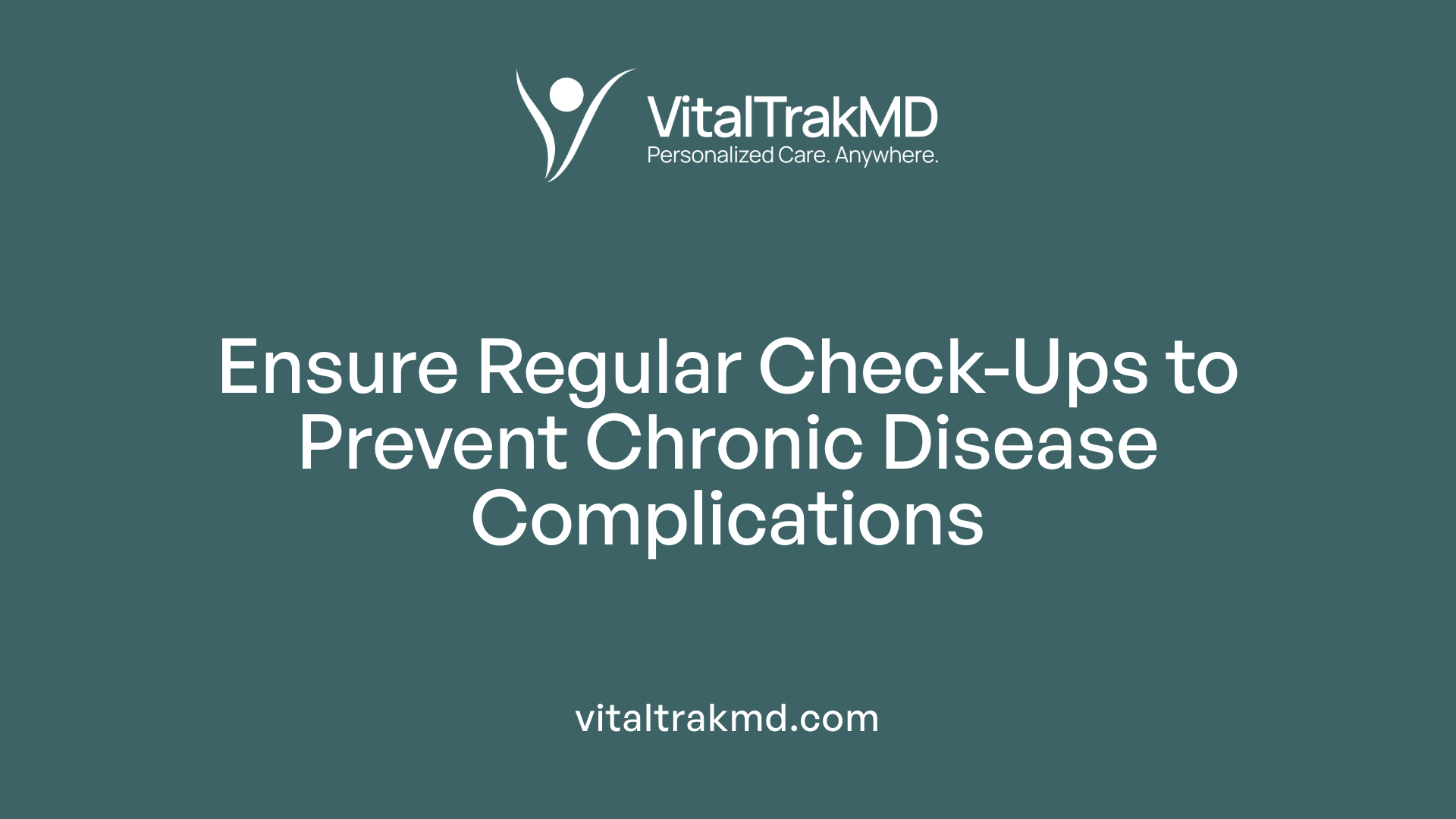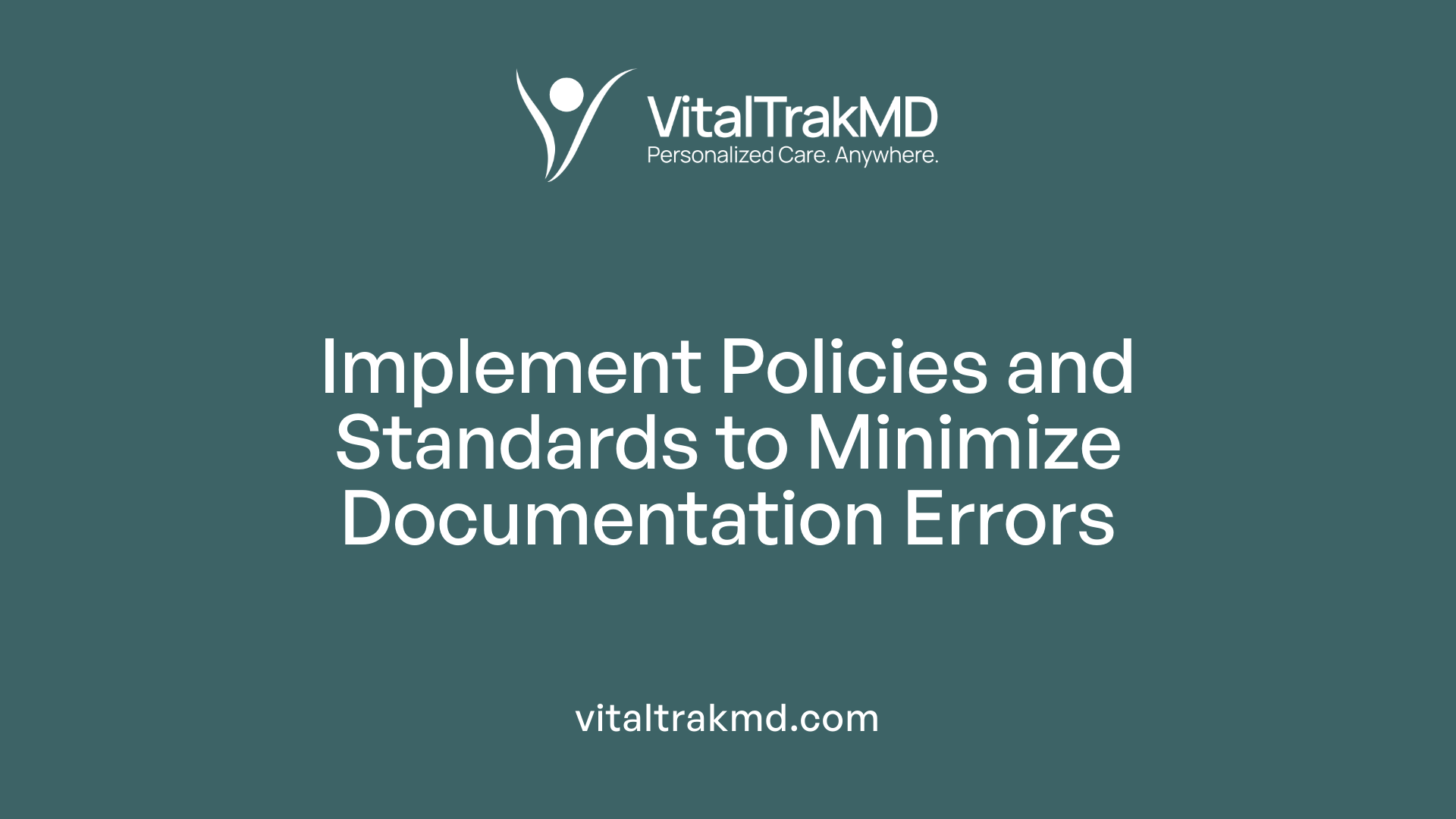How Inconsistent Check-Ins Lead to Incomplete Chronic Care Results

Understanding the Critical Link Between Consistency and Outcomes in Chronic Disease Care
Chronic disease management relies heavily on consistent and accurate documentation and patient check-ins. Inconsistent check-in practices and documentation errors can significantly impair care quality, leading to missed opportunities for early intervention, suboptimal treatment adjustments, and increased risk of adverse health outcomes. This article explores how variability in patient interactions affects chronic care, the importance of high-quality data, and strategies to enhance healthcare delivery through improved check-in processes.
The Role of Accurate Documentation in Patient Safety and Legal Compliance
What is the impact of data quality and documentation practices on patient safety and legal compliance?
Accurate and thorough documentation is vital in healthcare for safeguarding patient safety and ensuring legal compliance. When healthcare providers maintain high-quality data, it supports correct diagnoses, effective treatments, and minimizes the risk of medical errors. Proper records improve communication across care teams, especially during transitions such as moving from long-term care facilities to emergency departments.
Inconsistent or incomplete documentation can lead to serious adverse outcomes, including undertreatment or inappropriate care. For example, undocumented disease progression or vague transfer reasons can cause delays, misdiagnoses, or incorrect treatments. This not only jeopardizes patient health but also increases the risk of legal consequences for providers.
Legally, comprehensive records are essential to demonstrate standard of care and defend against malpractice claims. Accurate records serve as critical evidence in medicolegal reviews, supporting regulatory adherence and accountability.
To enhance data quality, healthcare systems should implement standardized data entry practices, enforce robust data governance policies, and utilize electronic health records with automatic error detection features. Staff training on documentation standards, combined with secure digital tools, helps reduce errors, improve interoperability, and increase overall trust in healthcare data.
Improved documentation practices not only protect patients but also promote compliance with regulations like HIPAA, ultimately leading to better health outcomes, higher patient confidence, and minimized legal risks.
The Critical Importance of Regular Medical Visits for Chronic Disease Prevention

Why is documentation during resident transitions from LTC to ED often inconsistent, and what are the implications?
Documentation during transitions from long-term care (LTC) facilities to emergency departments (ED) plays a vital role in ensuring continuity and safety of care. However, evidence shows that this documentation is frequently inconsistent or incomplete, with nearly 38.4% of analyzed transitions bearing such issues. These gaps often involve insufficient reporting of patient information, disease progression during transfer, or vague descriptions like 'sudden change in physical condition.'
Inconsistent documentation can result from various factors, including differences in understanding, language barriers among providers, or actual disease changes, especially in older adults with complex conditions like dementia, hypertension, or arthritis. Such discrepancies may lead to inappropriate treatments, delayed interventions, or even adverse patient outcomes.
How do reasons for patient transfer differ between cases with consistent and inconsistent documentation?
In cases with clear, consistent records, falls and shortness of breath are common reasons for transfer, often involving straightforward clinical presentations. Conversely, inconsistent cases frequently involve transfers due to poorly reported issues, worsening of known conditions, or ambiguous descriptors. These inconsistencies hinder clinical decision-making and can cause unnecessary or delayed interventions.
What strategies can improve documentation during healthcare transitions?
Enhancing documentation accuracy requires shared education and communication among LTC, EMS, and ED staff. Implementing standardized documentation protocols and electronic health records with automated error detection can reduce mistakes. Ongoing training helps providers better describe disease progression and transfer reasons, especially in complex cases like dementia. Improving data quality and communication pathways supports geriatric emergency care and ultimately benefits patient safety.
What is the impact of poor data quality on healthcare outcomes?
Errors related to data incompleteness, inaccuracy, or inconsistency are commonplace and can lead to misdiagnoses, medication errors, and treatment delays. For example, verifying insurance information can take over 12 minutes, contributing to inefficiency. Poor data quality also hampers healthcare providers’ ability to get a comprehensive view of patient histories, risking inadequate care and adverse outcomes. To combat these issues, healthcare systems are encouraged to establish standards, adopt electronic documentation tools, and ensure data validation and security.
How can improving documentation and data quality influence patient outcomes?
Better documentation reduces the likelihood of errors during critical care transitions, especially for vulnerable individuals with complex health needs. Accurate and timely data supports prompt decision-making, improves continuity of care, and enhances patient safety. When combined with initiatives like educational programs or behavioral interventions to increase appointment adherence, healthcare providers can significantly improve overall health outcomes, reduce hospital admissions, and prevent adverse events among high-risk populations.
| Aspect | Challenges | Solutions | Impact on Patient Care |
|---|---|---|---|
| Documentation during LTC to ED transitions | Incompleteness, ambiguity | Standardized forms, staff training, electronic tools | Reduced errors, improved care continuity |
| Healthcare data quality | Inaccuracy, inconsistency | Data validation, governance, automated error detection | Safer treatments, accurate diagnoses |
| Patient retention in care | Missed appointments | Behavioral messaging, reminders | Better adherence, health outcomes |
| Medication safety | Order errors, systemic issues | Double checks, clinical plausibility checks | Fewer medication errors, safer therapies |
Impact of Communication and Patient Engagement on Chronic Disease Outcomes

In what ways can inconsistent communication and patient engagement influence health outcomes in chronic care?
Inconsistent communication and a lack of patient involvement can undermine the management of chronic diseases significantly. When healthcare providers fail to communicate clearly or consistently, patients may become confused about their treatment plans, leading to poor medication adherence and missed follow-up appointments.
Patients with chronic conditions such as diabetes, hypertension, or heart disease need continuous, clear guidance to manage their health effectively. Without this, symptoms may worsen, and disease progression can occur unnoticed until serious complications arise.
Moreover, when patients feel disengaged or unheard, they often experience feelings of frustration, shame, or hopelessness. These emotional barriers decrease motivation, further impeding adherence to treatment regimens and lifestyle modifications.
Effective communication isn’t just about information exchange; it involves building trust and understanding. When healthcare teams maintain consistent, empathetic communication, they foster a collaborative environment that encourages patient participation.
Patient engagement strategies, including shared decision-making and personalized education, help patients feel valued and empowered. Such involvement has been shown to improve adherence, reduce hospital readmissions, and lower healthcare costs.
In summary, ensuring clarity and consistency in communication, while actively involving patients in their care, is essential for optimal health outcomes. It reduces misunderstandings, improves compliance, and ultimately leads to better management of chronic illnesses.
Risks of Incomplete or Inaccurate Patient Records in Chronic Care
What are the risks associated with incomplete or inaccurate patient records in chronic care?
Maintaining precise and thorough patient records is vital in managing chronic illnesses. When these records are incomplete or inaccurate, numerous problems can happen that threaten patient safety and the quality of healthcare.
One major risk is delays or errors in diagnosis. Critical information about a patient's medical history, previous treatments, or disease progression may be missing, leading healthcare providers to make decisions based on incomplete data. This can result in incorrect diagnoses, inappropriate treatments, or missed opportunities for early intervention.
Medication errors are another significant concern. Inaccurate or incomplete medication histories can cause incorrect prescriptions, harmful drug interactions, or missed alarms about allergies. Such mistakes often lead to treatment inefficacy or adverse drug reactions, further jeopardizing patient health.
The legal and safety implications are profound. Poor documentation can lead to challenges in defending care decisions if legal issues arise. Insurance and reimbursement processes also depend heavily on accurate records; gaps or errors can cause billing denials, audits, or penalties for non-compliance, especially under strict regulations like HIPAA.
Incomplete data can impair emergency responses, as vital information may not be available quickly. This delay can worsen health outcomes during critical moments. Furthermore, inaccuracies may cause distrust among healthcare workers, complicate coordination among providers, and lead to inefficient workflows.
Overall, neglecting the importance of complete, accurate records risks patient safety, undermines quality care, increases healthcare costs, and exposes providers to legal liabilities. Regular updates, proper documentation protocols, and reliable data management are essential to ensure safe, effective, and compliant chronic care.
The Influence of Care Coordination on Managing Chronic Diseases
How does documentation during resident transitions influence the quality of patient care?
Accurate and consistent documentation during transitions from long-term care (LTC) to emergency departments (ED) is vital for ensuring appropriate treatment and safe patient outcomes. Inadequate or inconsistent records can lead to miscommunication, delayed interventions, and increased risks of adverse events. For example, nearly 40% of analyzed transfers had documentation that was inconsistent, often involving vague descriptions like 'sudden change in physical condition' or missing details about disease progression.
Pre-existing conditions such as hypertension (61.7%), dementia (59.9%), and arthritis (40.8%) are common in these residents, making precise documentation even more critical. When transfer reasons are unclear or incomplete, healthcare providers may miss subtle signs of deterioration, especially in patients with complex illnesses or cognitive impairments. Sharing updated, clear records helps facilitate appropriate care, timely interventions, and better patient safety.
What are the consequences of poor documentation during emergency care transitions?
Poor documentation can result in multiple issues, including undertreatment, unnecessary tests, and treatment delays. The inconsistencies often reflect differences in understanding among healthcare providers or actual disease progression. For instance, transfers due to conditions like worsening dementia or atypical presentations in older adults are frequently poorly reported. Such gaps hinder healthcare providers' ability to make informed decisions.
Additionally, documentation errors such as incompleteness and illegibility create barriers to effective communication. These issues are often driven by manual record-keeping, occupational stress, and lack of standard protocols, emphasizing the need for electronic record systems with automatic error detection.
How can improving training and communication enhance documentation and patient safety?
Enhanced education across care settings—including LTC, EMS, and ED—can improve communication and documentation accuracy. Shared training helps align understanding of disease progression, transfer reasons, and terminology. For example, better training on recognizing atypical presentations in dementia patients can reduce ambiguities.
Implementing standardized documentation policies, using electronic health records with built-in validation, and fostering multidisciplinary teamwork are strategies that can significantly enhance data quality. Strong communication reduces discrepancies, promotes consistency, and ultimately results in safer, more effective emergency care during resident transitions.
What are recommended approaches to improve documentation quality?
- Implement universal standards and guidelines across healthcare settings.
- Use electronic health record (EHR) systems with features for automatic error detection.
- Provide ongoing training on documentation best practices.
- Foster collaboration and communication among LTC, EMS, and ED staff.
- Promote continuous quality improvement initiatives focused on data accuracy and completeness.
Better documentation not only supports immediate patient safety but also enhances overall healthcare quality and patient outcomes in managing chronic conditions.
Consequences of Check-In Variability and Documentation Gaps

How do inconsistent check-ins and documentation gaps affect the management and outcomes of chronic diseases?
Inconsistent check-ins and gaps in documentation can have serious repercussions for managing chronic health conditions. When information is missed or inaccurately recorded, healthcare providers may not recognize early signs of disease worsening, leading to missed opportunities for timely treatment adjustments.
Poor documentation practices—characterized by incompleteness, inaccuracies, and inconsistencies—are often caused by factors such as high occupational stress, reliance on manual data entry, and the absence of standardized documentation guidelines. These issues can create communication barriers among care teams and hinder clear understanding of patient histories.
As a result, patient safety is compromised. There is an increased risk of misdiagnosis, medication errors, and adverse events like hospital readmissions and even mortality. For example, if disease progression is not properly documented, necessary changes in treatment may be delayed, worsening patient outcomes.
Continuity of care also suffers. When providers lack reliable and complete information, personalized treatment plans become difficult to implement. Patients may experience fragmented care, leading to dissatisfaction and decreased trust.
Legal and reimbursement risks are further elevated if documentation does not meet standards required for medical-legal compliance or insurance claims. Proper, thorough, and standardized documentation is essential to ensure ongoing effective care, reduce errors, and avoid legal pitfalls.
To address these issues, healthcare systems should focus on enhancing documentation quality through regular staff training, adoption of electronic health records with automatic error detection, and the development of standardized documentation protocols. Such improvements can lead to better disease management, safer care, and higher patient satisfaction.
Digital Tools: A Solution to Care Gaps and Check-In Inconsistencies
How can digital health tools and technology improve check-in consistency and reduce care gaps in chronic disease management?
Digital health tools and technology play a vital role in enhancing the quality and reliability of care for patients with chronic conditions. One of the main advantages is enabling remote monitoring and data collection. This allows healthcare providers to continuously observe a patient's health status outside the clinical environment, capturing real-time information that might otherwise be missed during periodic visits.
Automated reminders and personalized alerts further support patients in adhering to their treatment plans. These alerts can prompt patients to schedule regular check-ins, take medications as prescribed, or alert them about significant health changes requiring immediate attention.
Emerging technologies like artificial intelligence (AI) and advanced analytics empower healthcare providers to analyze vast amounts of collected data. This enables early detection of deterioration or potential complications, facilitating proactive interventions before serious issues develop. Such early warning systems are particularly beneficial in managing complex conditions like diabetes, heart failure, or opioid use disorder.
Implementing these digital solutions not only maintains high standards of care but also improves patient outcomes by preventing avoidable hospitalizations and reducing emergency incidents. Furthermore, AI-driven insights help in tailoring individual care strategies, promoting personalized treatment plans that are responsive to each patient’s unique needs.
Ultimately, adopting comprehensive digital health tools supports a more proactive, efficient, and patient-centered approach to chronic disease management. This integration alleviates the burden on healthcare systems by reducing unplanned care and fostering ongoing patient engagement.
Strategies to Improve Check-In Consistency and Care Continuity
What strategies can healthcare systems implement to improve check-in consistency and care continuity for patients with chronic conditions?
Ensuring consistent documentation and seamless care for patients with chronic illnesses requires a multifaceted approach. First, adopting patient-centered and culturally sensitive methodologies is vital. Tailoring education and self-management strategies to the specific cultural and social contexts of patients encourages active engagement and adherence.
Technology plays a crucial role. Implementing electronic health records (EHRs) allows real-time data sharing among care providers, reducing documentation gaps. Remote patient monitoring and telehealth services enable continuous engagement, especially for those with mobility issues or living in remote areas. These tools help identify deterioration early, preventing unnecessary hospital visits.
A collaborative, multidisciplinary team approach enhances care coordination. Including case managers, health educators, and community health workers helps address social determinants of health, such as access to nutritious food or safe exercise environments. Regular routine check-ups, medication adherence, and lifestyle counseling further stabilize chronic conditions and prevent complications.
Community engagement is also essential. Partnering with local organizations to improve social support networks, access to healthy resources, and patient education fosters a supportive environment for sustained health management. This integrated strategy promotes a consistent, patient-centered care pathway that adapts to individual needs and promotes better health outcomes.
The Role of Policy and Standardization in Reducing Documentation Errors

What policies and standards can healthcare organizations adopt to reduce documentation errors?
Healthcare organizations can significantly improve the accuracy and consistency of documentation by adopting a combination of technological solutions, staff training, and regulatory frameworks.
Implementing comprehensive electronic documentation systems is fundamental. These systems should include automatic error detection and validation features that flag incomplete or inconsistent entries, helping healthcare providers identify and correct mistakes in real-time.
Alongside technological tools, regular training programs are essential. Educating staff on standardized documentation procedures, best practices, and the importance of data accuracy fosters a culture of meticulous record-keeping and accountability.
Establishing clear regulatory frameworks and quality standards helps create uniform documentation practices across different care settings. Such standards promote interoperability, legal compliance, and ensure that all practitioners follow consistent procedures.
Promoting a culture of continuous quality improvement encourages staff to view documentation accuracy as a shared responsibility. This approach includes ongoing education, routine audits, and feedback mechanisms to identify and address gaps.
Incorporating these policies and standards collectively enhances data reliability, reduces errors, and ultimately leads to better patient safety and care outcomes. It also ensures that healthcare providers meet legal and regulatory obligations while fostering trust and efficiency in chronic care management.
The Need for Continuous Education to Enhance Documentation and Communication
How can ongoing staff training improve documentation practices and communication in healthcare?
Ongoing education for healthcare staff plays a vital role in improving how patient information is documented and communicated across different settings. Regular workshops, training sessions, and inter-professional education programs ensure that health professionals stay updated on the latest standards, policies, and technological tools.
Training helps reduce common documentation issues such as incompleteness, inaccuracies, and ambiguities. When staff are educated about the importance of precise, complete, and timely data entry, they are more likely to produce consistent and reliable records. This consistency is especially crucial during transitions of care, like from long-term care facilities to emergency departments, where incomplete or inconsistent documentation can lead to suboptimal patient outcomes.
Inter-professional education encourages better understanding and collaboration among various healthcare providers, such as nurses, physicians, EMS personnel, and administrative staff. Improved communication reduces misunderstandings, errors, and redundant efforts.
Moreover, staying abreast of evolving policies, regulations, and best practices ensures that staff are compliant and can effectively contribute to quality improvement initiatives. When healthcare teams are well-informed, they are better equipped to handle complex cases and support patient safety.
Overall, fostering a culture of continuous learning enhances the skills and knowledge of healthcare professionals. This investment in education directly benefits patient care by promoting accurate documentation, fostering clearer communication, and reducing preventable errors.
Enhancing Data Integration and Use of Technology for Better Outcomes
What strategies can be employed to improve healthcare data quality and integration?
Improving healthcare data quality and integration involves multiple strategic approaches. One fundamental step is adopting standardized data formats and definitions across various health information systems. Consistency in data entry and classification reduces discrepancies and facilitates smoother data sharing.
Implementing interoperable health IT systems is also critical. These systems enable seamless data exchange among hospitals, clinics, emergency services, and long-term care facilities, ensuring that all providers have access to accurate and up-to-date information.
Robust data governance frameworks play a vital role in maintaining data accuracy, privacy, and security. These frameworks establish clear policies, procedures, and accountability measures for managing healthcare data responsibly.
Integrating diverse data sources, such as electronic health records (EHRs), remote patient monitoring devices, and insurance claims, creates comprehensive profiles for each patient. Such integration supports detailed clinical insights and informed decision-making.
Advanced analytics and real-time dashboards allow healthcare providers to identify trends, detect anomalies, and address care gaps promptly. This proactive approach is essential for managing chronic conditions and reducing adverse outcomes.
Quality assurance tools, including automated error detection and validation processes, improve overall data reliability. When combined, these strategies foster a healthcare environment where data supports safer, more effective, and coordinated patient care.
Conclusion: Building a Safer and More Effective Chronic Care System
What are the key takeaways for improving chronic care through consistent check-ins and documentation?
Enhancing chronic care outcomes depends on a multi-faceted strategy that emphasizes reliable check-ins, precise documentation, and the integration of technological innovations. Variability in patient handovers, especially during transitions from long-term care to emergency settings, often results in insufficient or inconsistent data, impacting patient safety and treatment quality.
To bridge these gaps, implementing electronic health records (EHRs) with automatic error detection mechanisms is essential. Standardized documentation protocols and ongoing staff training can reduce errors related to incompleteness and ambiguity, especially important for older adults with complex health profiles such as dementia or multiple comorbidities.
Technological tools like remote patient monitoring and artificial intelligence analytics offer proactive support, enabling early detection of health deterioration and facilitating timely interventions. Policy reforms that prioritize data quality, interoperability, and care standards reinforce these improvements, ensuring that information is accurate, timely, and accessible across care settings.
Empowering healthcare teams through continuous education fosters better communication and shared understanding across care disciplines. At the same time, engaging patients actively promotes adherence and improves health literacy. When patients understand their conditions and are involved in their care plans, the risks of miscommunication decrease, and trust in the healthcare system increases.
This comprehensive approach can help reduce unnecessary hospitalizations, prevent adverse events, and enhance the overall quality of care. As these strategies become integrated into routine practice, they will contribute to a more resilient, efficient, and safe chronic disease management infrastructure.
In summary, consistent documentation, technological support, and empowered care teams—coupled with engaged patients—are fundamental to transforming chronic care into a more reliable and patient-centered system. Implementing these measures will facilitate early intervention, improve health outcomes, and promote sustainable, high-quality healthcare delivery.
Summary and Final Thoughts

What are the main conclusions regarding the impact of check-in consistency on chronic care outcomes?
The consistency of documentation and communication during patient transitions and check-in processes plays a critical role in the quality of ongoing healthcare, especially for individuals with chronic conditions. When patient records are incomplete, inaccurate, or inconsistent—common issues highlighted by systematic reviews—healthcare providers face increased risks of misdiagnosis, incorrect treatments, and medication errors. These errors can lead to adverse health outcomes, including higher rates of hospitalizations and mortality.
For example, studies show that inconsistent documentation concerning disease progression or medication orders often results in delayed or inappropriate interventions. This is especially true in complex cases like older adults with dementia or multiple diagnoses where atypical presentations are common.
Effective data handling and clear communication allow healthcare teams to respond promptly and appropriately. When documentation is inconsistent, providers may miss early signs of deterioration, leading to preventable complications.
Strengthening documentation practices through standardized protocols, electronic health records with error detection, and ongoing staff training can enhance accuracy. Moreover, fostering teamwork and continuous engagement among emergency, primary, and long-term care providers ensures better coordination. Improved data quality and shared understanding are the foundation for proactive, patient-centered care.
The role of technology and policy
Innovative health IT solutions, such as electronic health records (EHR) systems equipped with automated error detection, are vital for reducing documentation errors. Policies that mandate standardized documentation procedures and develop interoperability across care settings help bridge information gaps.
In addition, implementing policies that promote shared training across care teams ensures all staff understand and adhere to best practices in documentation. These measures collectively improve the reliability of patient data, supporting better decision-making and safer care.
The importance of teamwork and engagement
Engaged healthcare teams, including nurses, physicians, and emergency responders, are essential for maintaining high-quality documentation and patient safety. Training programs that emphasize critical thinking and verification processes empower staff to identify and correct inconsistencies early. Patient involvement is also crucial; informed and engaged patients can provide essential information, reducing ambiguities.
In summary, addressing documentation inconsistencies through technological advancements, supportive policies, and collaborative team efforts significantly impacts chronic care outcomes. Enhancing check-in and documentation processes leads to more accurate diagnoses, timely interventions, and ultimately, better health for patients managing long-term conditions.
Moving Toward a More Consistent and Safer Chronic Care System
Achieving high-quality, complete, and reliable data through consistent check-ins and robust documentation practices is vital for optimal chronic disease management. Embracing digital health innovations, enforcing strict policies, fostering continuous education, and building strong care team collaborations are essential strategies to overcome current challenges. When healthcare systems prioritize regular, accurate, and systematic patient engagement, they can minimize care gaps, prevent complications, and enhance overall patient safety. Ultimately, these efforts will lead to more effective, equitable, and patient-centered chronic care that meets the complex needs of diverse populations and improves health outcomes over the long term.
References
- A first look at consistency of documentation across care settings ...
- The success of behavioral economics in improving patient retention ...
- 7 Common Roadblocks in the Patient Check-in Process
- Effects of Non-Face-to-Face Chronic Care Management on Service ...
- Documentation Errors and Deficiencies in Medical Records
- Data Quality Issues in Healthcare: Understanding the Importance ...
- (PDF) Consistency in performance evaluation reports and medical ...
- What do double-check routines actually detect? An ... - BMJ Open
- Background: Ongoing Efforts in Care Coordination and Gaps ... - NCBI
Recent articles
Want to Feel Better and Live Healthier?
Join hundreds of patients taking control of their health with personalized care that fits their life – not the other way around.
Rated 4.8/5 by 32+ customers







